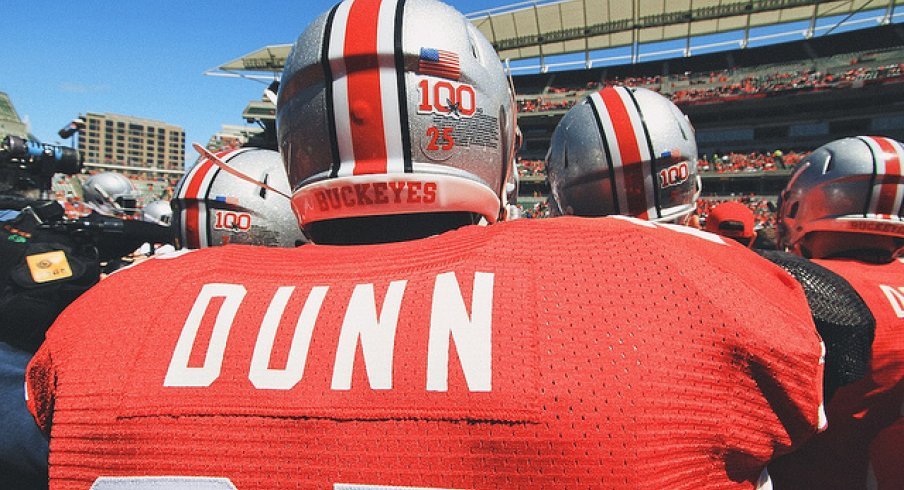One of the more unique football stories entering the 2010 season was at linebacker. Ohio State had two starters returning at weakside linebacker and middle linebacker in Ross Homan and Brian Rolle. It lost strongside linebacker Austin Spitler, an unsung hero of the 2009 Rose Bowl championship campaign, to graduation. Who replaced him for a season in which Ohio State entertained playing for a national championship at the season's end was a preaseason talking point.
The battle that emerged pit juniors Etienne Sabino and Andrew Sweat against each other for the position. Both were well-regarded linebacker signees from that infamous "Block O" 2008 recruiting class. However, the position battle came with a twist. The loser of the preseason battle would redshirt. This was Etienne Sabino, who maintained a redshirt through that 2010 season.
It was unique that a player in the midpoint of his college career could redshirt while healthy and capable of being a reliable presence in the two-deep at the worst. The custom is redshirts go to players with season-long injuries or, more accurately, first-year players whose development lags behind other true freshman capable of having an immediate effect on the football team.
Already, Urban Meyer redshirted guys like Michael Thomas and Bri'onte Dunn in the second year of their Ohio State career. It is conceivable that Jacoby Boren could redshirt his third year at Ohio State as well. What was a sui generis talking point for the 2010 season is becoming commonplace for Urban Meyer's program.
Why redshirt guys like Dunn and Thomas midway through their careers? The easiest answer comes with reference to the situation for Sabino and Sweat in 2010. The coaching staff at the time felt both were capable of being two-year starters as upperclassmen, though only one would command that type of playing time on the 2010 football team. When Homan and Rolle graduated, the loser of that position battle between Sabino and Sweat would get one of those spots for two years. A mid-career redshirt says as much about the wealth of talent at the position as it does the development of the player.
Likewise, Dunn and Thomas were in crowded depth charts, Dunn especially. Carlos Hyde and Jordan Hall were seniors and proven commodities in a mostly one-back offense. Ezekiel Elliott looked the part of a true freshman phenom and Warren Ball redshirted his first year in the program in 2012. Dunn gains nothing from having little playing time in this situation and Ohio State gains nothing from him wasting a year of eligibility against the likes of Florida A&M and Purdue.
However, Meyer's use of the mid-career redshirt suggests a different message. In discussing Dunn's spring and redshirt for the previous year, position coach Stan Drayton said Dunn lost some of his "hunger" after the 2012 season. It was a season in which Dunn had 133 yards and two touchdowns in limited duty as a true freshman.
Dunn's development stunted shortly thereafter. An ankle injury was partly to blame but other factors emerged. Awareness and execution in practice fell below benchmarks. Dunn also appeared unable to contribute to special teams, making it possible for a coaching staff to redshirt him when it had a wealth of other options.
A similar comment could be made about Michael Thomas. Thomas had three receptions for 22 yards in his first year at Ohio State though his development did not mature from there. Thomas has physical tools at wide receiver that Ohio State could have used in 2013 but Thomas could not separate himself from the pack. With multi-year starters like Corey Brown, Devin Smith, and Evan Spencer already secure in their positions, Thomas redshirted in 2013.
The good news is the redshirts may have had the intended effect of motivating both players. Drayton has praised Dunn for being much crisper this point in 2014 than he was in 2013. Thomas has also been posting videos of himself on Twitter looking every bit the nephew of Keyshawn Johnson he is.
One question nags, especially for this 11W writer who tries to project first-year redshirts on members of the incoming recruiting class. Is a mid-career (here: second year) redshirt an acknowledgement of a mistake by the coaching staff in putting a player on the field as a true freshman? It does seem to communicate that a true freshman campaign with spot playing time was not an investment that materialized in the desired sophomore transition.
Barring an injury waiver, players have five years to play four seasons. There is no real loss for a player or coaching staff in the mid-career redshirt. That said, a mid-career redshirt as a signal of an inadequate early career development has another implication for how Ohio State fans follow the program under Urban Meyer.
Meyer has boasted that "we don't redshirt here at Ohio State." Fans and incoming players may be confusing the message of "we don't redshirt" as a suggestion of immediate playing time at Ohio State as a trial by fire. It is less a guarantee and more of a message to incoming recruits to be game-ready when they enroll at Ohio State. Mid-career redshirts like those for Dunn and Thomas may clarify the meaning behind that message even if the spot playing time received before the redshirt may muddy it.
Meyer's often cited "we don't redshirt" quote more accurately means "we don't want to redshirt" and "don't enroll expecting to redshirt". Those who receive the mid-career redshirts by Urban Meyer at Ohio State can be understood as not playing to their potential unlike the situation in 2010 for Etienne Sabino and Andrew Sweat.


